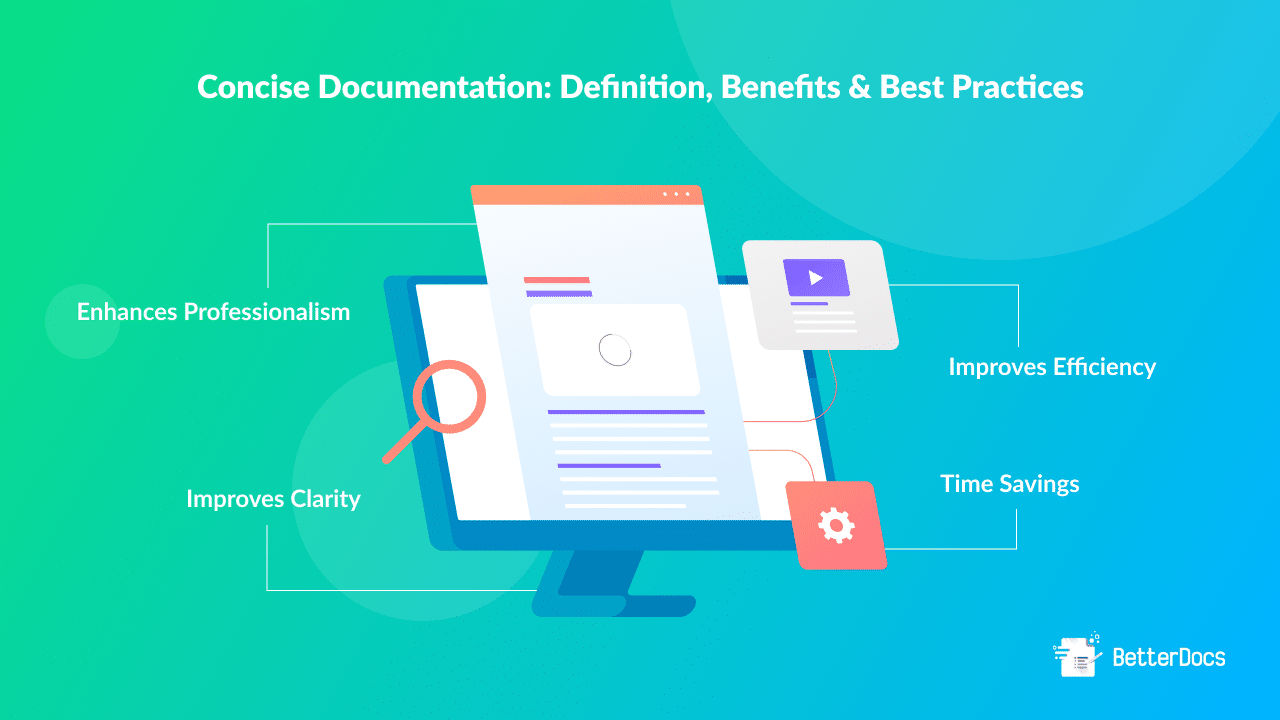Concise documentation can help you save time, increase productivity, and project professionalism, whether you are a writer, a business owner, or a student. But before you can master the art of creating concise documentation, you need to understand what it is. In this blog, you will learn the meaning of concise documentation, its many advantages, and how to develop one for your website. So let’s get going.

Defining Concise Documentation In A Few Words
Concise documentation refers to writing that is simple, straightforward, and to the point. The major goal of this kind of documentation is to communicate information clearly while saving the reader’s time by omitting superfluous details.
Imagine you are a manager at a large company, and you need to create a training manual for new employees. You could create a lengthy, detailed document that covers every possible scenario, but this would take a lot of time and may overwhelm the new hires.
Instead, you decide to create concise documentation that focuses on the most important information new employees need to know. You break the manual down into short, easy-to-read-and-understand sections that cover the basics of the job, such as company policies, safety protocols, and customer service expectations.
So, in a nutshell, with concise documentation, you can provide new hires with the information they need to get started without overwhelming them with unnecessary details. This approach effectively saves time for both you and the new hires, allowing them to quickly get up to speed and start contributing to the company’s success.
Furthermore, if the training manual is well-written and concise, it can be used as a reference tool for employees to consult when needed, which can save time and improve efficiency in the long run.
Benefits Of Creating Concise Documentation

In this section, you are going to get some major benefits of creating Concise Documentation that you can enjoy. Take a look below:
📑 Improves Clarity:
By eliminating unnecessary details, concise documentation increases clarity. The reader can quickly understand the document’s purpose and content.
📑 Time Savings:
Concise writing of documentation saves time for both the person who writes and the person who reads it. The writer can quickly complete going through the document without having to spend time on unnecessary details that might lead to more confusion. The reader can easily get the information they need without having to go through pages of unnecessary details.
📑 Fewer Errors:
Fewer errors would occur as a result of concise documentation being easier to read and understand. You can easily discover writing errors and make corrections right away.
📑 Improves Efficiency:
By enabling the reader to access the information they require quickly, concise documentation increases efficiency. When time is of the essence, this can be very helpful.
📑 Enhances Professionalism:
The use of concise documentation shows the writer’s commitment to offering clear and accurate information. As a result, the author’s reputation and professionalism are enhanced.
Best Practices To Write Concise Documentation In 2024

Now that we’ve established the benefits of using concise documentation, let’s take a closer look at how to create it. While there are many ways to approach concise writing, there are some best practices that can help you achieve your goals.
In this section, we will explore some of the most effective strategies for writing concise documentation. From identifying your audience to using formatting to your advantage, these tips will help you create clear and effective documents that get to the point quickly and efficiently. Whether you’re a seasoned professional or just starting, these best practices can help you improve your writing skills and communicate more effectively.
✅ Identify your audience: Before you begin writing, identify your target audience and their specific needs. This will help you focus on the most important information and avoid unnecessary details.
✅ Use clear and simple language: Write in clear and simple language, avoiding technical jargon and complex sentence structures. This makes it easier for your audience to understand the information you’re presenting.
✅ Focus on the main points: Identify the main points you want to convey and focus on those. Don’t try to cover every possible detail or scenario.
✅ Use formatting to your advantage: Use headings, subheadings, and bullet points to break up the information and make it easier to read and understand.
✅ Eliminate unnecessary words and phrases, and avoid repeating information. Get to the point quickly and use as few words as possible.
✅ Write in the active voice, which is more direct and concise than the passive voice. For example, instead of writing “The report was completed by the team,” write “The team completed the report.”
✅ After you’ve written your document, edit it carefully to eliminate any unnecessary words or phrases. Then, proofread it to ensure there are no errors or typos.
Write Concise Documentation Effortlessly!
By now, you can tell that effective communication in any industry depends greatly on concise documentation. You can develop documents that save time, boost clarity, decrease errors, and improve professionalism by concentrating on the most crucial information and utilizing straightforward language.
To write clear, effective documentation, it’s crucial to know your audience, concentrate on the key ideas, make good use of formatting, and thoroughly revise and proofread. You may write concise, effective texts that swiftly and effectively get to the point by adhering to these best practices.
Whether you are writing an academic paper, a corporate report, a training manual, or product documentation, writing clearly can help you communicate more effectively and accomplish your objectives. You can boost productivity and your reputation by taking the time to write simple, concise documents.

So why not give it a shot and discover the advantages of concise documentation? And while you’re at it, explore BetterDocs, the best knowledge base tool for WordPress and Shopify. We hope you find this blog helpful. Feel free to share your feedback by commenting below. For more updates, check out our blog page. You can join our WordPress experts community on Facebook to get all the latest updates.
Read More Exciting Blogs Below!
📄 The Future Of Technical Documentation: 5 Top Trends To Watch Now
📄 How To Write A SOP Documentation?







